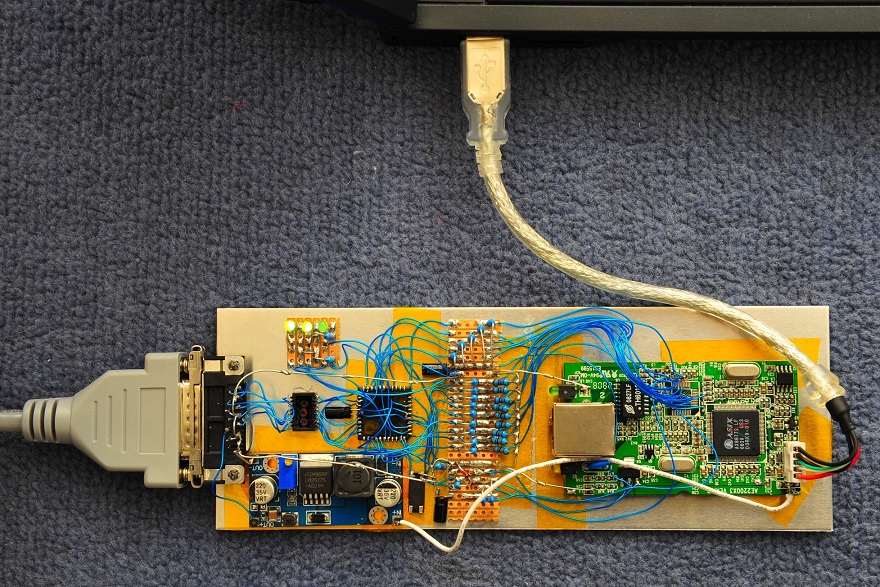Introduction
I can hardly claim to have worked professionally with 10BASE5 as when I first started building my own 10BASE2 networks in 1997, 10BASE5 was long obsolete. Back then, I knew about 10BASE5, but it wasn't practical, affordable or interesting enough for me to attempt building one.
Fast forward to 2012, now this technology has more or less gained vintage status, making it of interest. In 2010 I wandered around the Vintage Computer Fair at Bletchley Park; every imaginable computing project was on display, but there was one thing notably absent: Vintage networking. It seems that while every antique computer in existence had been restored and put on display, no one had resurrected the contemporary interconnects used by these machines. This absence became part of the inspiration for this project.
I don't have any interest in buying up a bunch of 1980s machines for my network, instead I wanted to focus on connecting it to technology in use now, because let's face it, if the guys at VCF can post on Twitter using a ZX spectrum, why can't I check my Facebook through a 10BASE5 connection?
Target audience
I've written this page primarily for people like myself, who came into the computing scene just a bit too late to have ever seen this technology in use. A 1980s network engineer can safely skip this page.
Connecting contemporary nodes & networks to a 10BASE5 network in 2012
In order to connect to a true 10BASE5 network, network adapters with AUI are required. AUI stands for Attachment Unit Interface. It is in effect, a media independent form of all of the physical 10Mbit ethernet variants, which I shall call 10BASE-X. AUI was to 10BASE-X what MII is to 100BASE-X, with the exception that MII is rarely found as an external connector.
Unfortunately for this project, networking equipment with external AUI connectors is becoming rather difficult to find.
As I see it, there's 2 options:
- Build true 10BASE5 nodes using equipment natively supporting AUI
- Bridge to something else i.e. 10BASE-T
Building true 10BASE5 nodes
Not many options remain for connecting to modern PCs. Here's a few:
ISA Cards
While this can be done, modern mainboards with ISA slots are niche and very expensive. I ruled out this option.
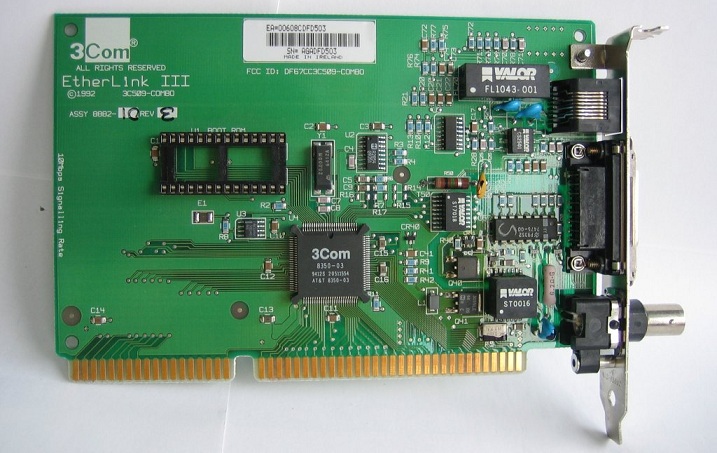 3c509 ISA network card with AUI interface. No thanks. |
PCI Cards
Fortunately, some modern PCs still have 32-Bit/5 volt parallel PCI slots, also, PCI and 10BASE5 had enough overlap that a small number of products were manufactured. A couple of examples are the 3Com 3C900B-COMBO, and 3C905B-COMBO. At the time of writing there were a fair few of these on eBay, but often for outrageous sums of money. Fortunately I managed to pick up a couple for a few quid. 64-Bit Windows drivers do not exist, making Windows 7 32-bit likely the last version of Windows able to make use of them, short of writing some new drivers. All versions of Linux will work OK with these.
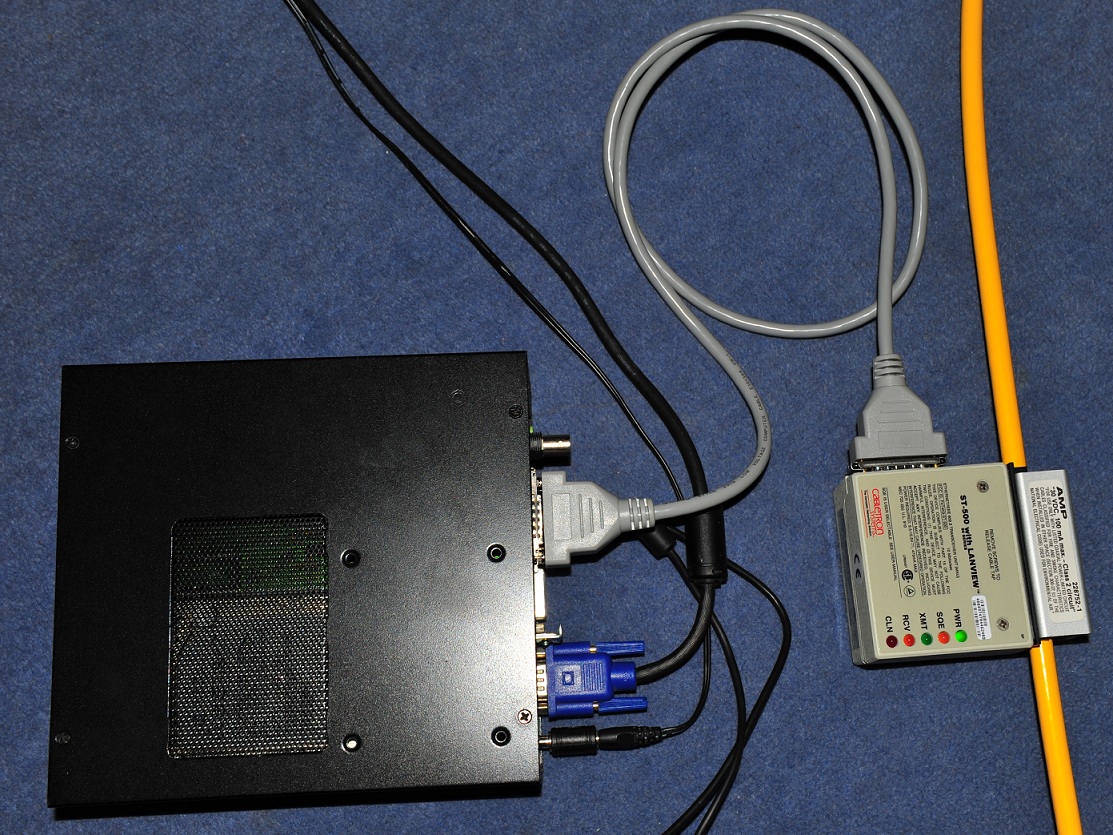 My only 'true' 10BASE5 node. Using a 3Com 3c905B-COMBO NIC with AUI |
USB or other solutions
As far as I can tell no USB product was ever made. With 10BASE5 MAU's requiring 12 volts and some 5 or more watts of power, over and above what USB can provide, this would be a problematic proposition. Also, no single chip "USB with AUI" solutions exist. From my research, it seems theoretically possible to create a 2-chip adapter, with external power supply, but apparently there is no market for such as a thing.
But that didn't stop me from building one. Above is what is quite possibly one of the worlds only USB Ethernet Adapters with AUI interface. I have a seperate project page for this here.
Routers
A Cisco NM-1E2W module could be used if one has a large ISR kicking around.
Bridging 10BASE5 to modern twisted pair networks
10BASE-T Hubs equipped with AUI
Using a 10BASE-T hub with AUI to bridge to a twisted pair network is probably the easiest approach. There's thousands of these for sale on eBay for peanuts, but in my case, having one of these on each node would make the setup rather clunky.
10BASE-T to AUI Media converters
What I was really looking for was a few of these little boxes. Easily mistaken for a 10BASE-T MAU, these (unlike the former which tend to be spilling out of every I.T. junk box in the land) are fairly uncommon.
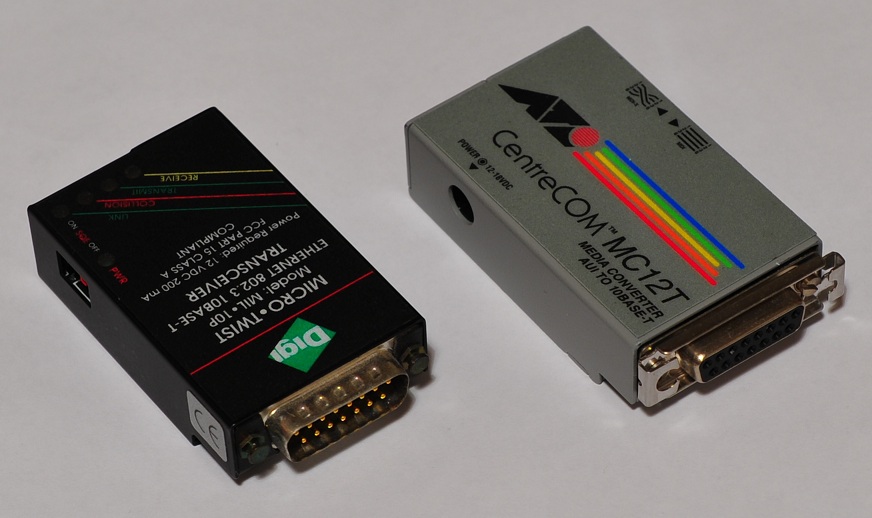 An Allied Telesis MC12T next to an ordinary 10BASE-T MAU. Spot the difference? |
The shopping list
To keep the cost of this project to a minimum, I decided my network would only have 3-4 nodes as this was sufficient to demonstrate a proper shared media network as opposed to a 2 node effective "point to point" link. For this I sourced the following components:
- 2x 3Com 3C900B-COMBO PCI NICs with AUI
- 3x MiLAN MIL-130A AUI-to-10BASE-T bridges
- 1x MiLAN MIL-10P 10BASE-T Transceiver (for testing AUI nodes)
- 1x Allied Telesis MC12T
- 6x Cabletron ST-500 MAU's
- 3x AMP 228752-1 Vampire taps
- 2x AMP 221914-1 Intrusive N connector taps
- 5x AUI Drop cables
- 15M of Belden #9880 cable
- 2x 50ohm N terminators
- 2x N female to female couplers
- 10x UNC 4-40 x 1.1/2" countersunk screws (to replace missing ones on my MAUs)
The cable
A common belief persists that 10BASE5 used RG-8/U cable. This, for the most part, appears to be untrue. The cable used was purpose designed for 10BASE5 and manufactured by Belden under the part number 9880 (A few other compatible cables may exist). The reason #9880 cable was specified is that several variants of RG-8 exist with varying dimensions and manufacturing standards. Given that the main form of connection of MAU's to 10BASE5 networks was by the precisely designed prongs in "Vampire taps", cable dimensions and dielectric consistency had to be spot on.
A network designed using only intrusive N connector taps such as AMP 221914-1 could get away with using pretty much any 50 ohm coax, but then the sum total of insertion losses created by each node may prevent the full 500M segment length from being achieved. Also, this approach wouldn't permit addition of new nodes without bringing down the network. After an evening of wrestling with RG-8/U cable (why oh why didn't I just buy RG-58) while attempting to make a short test lead, I think I'll stick with the Vampire Taps.
For someone like me who hadn't encountered it before, no amount of looking at pictures could prepare for how big this stuff is. Short of high power transmission cables, it's the largest coaxial cable I've ever seen. It is also very heavy, rigid and the bend radius is absurdly large.
Another interesting feature of this cable is the black bands which appear every 2.5M. In 10BASE5 networks, MAUs can only be attached at 2.5M intervals, this is to ensure that signal reflections generated by taps stay out of phase, which stops them compounding across the whole segment. In a small network such as mine, it's probably not so important to respect this tap placement rule, but I'll respect it anyway.
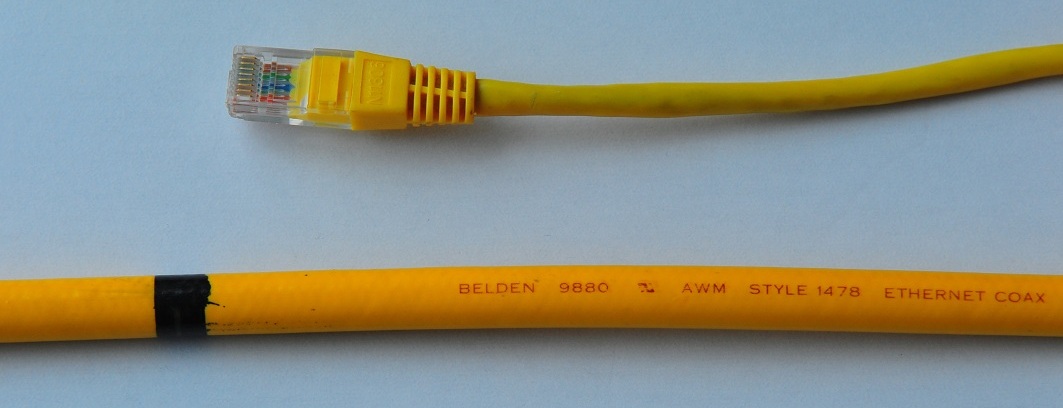 Belden 9880 next to standard CAT5E cable. Either side of this frame is 10 kilos of steel, about the minimum required to hold this stuff down for the photo |
Connectors
Unlike the BNC connectors found on 10BASE2, the official connector used by 10BASE5 (where connectors are required) is the N connector. While still used extensively in lab/specialist environments, this large coaxial connector isn't something the average 'tech dude' is likely to encounter these days. They perform exceptionally, have an intrinsic impedance of 50 ohms, are fairly common/inexpensive and easily handle the large sized #9880 cable.
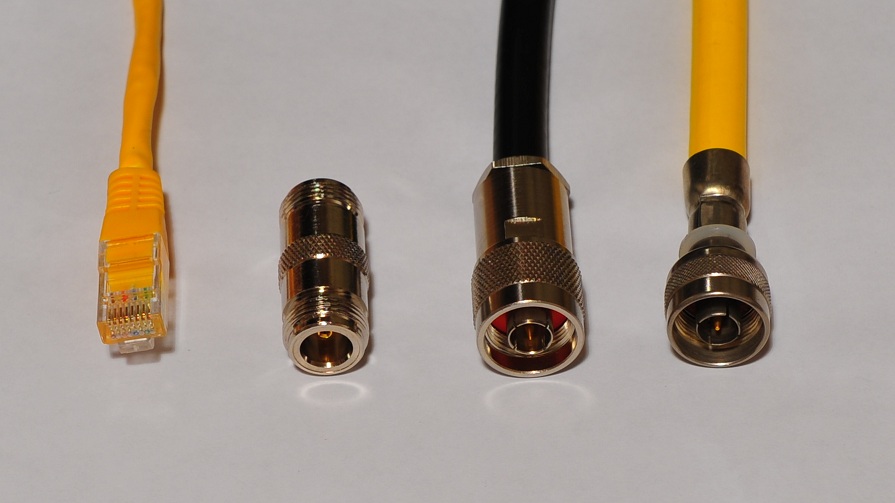 N Connector and joiner with CAT5E patch cable for comparison |
AUI Drop cables
These cables sporting male and female 15-pin D-sub connectors, connect a node to the MAU. Since the MAU is bolted to a rigid behemoth piece of coax, it wasn't exactly convenient to try and drag that lot down to the back of a PC, so these cables bridged that gap. With a maximum length of 50 metres, that gap can be very large indeed. Also, given that taps could only be placed at 2.5M intervals, a world without drop cables would lend its self to much humour around the office, at the expense of well-intended PC and desk placement considerations.
One notable feature is the slide locking mechanism used in place of the usual UNC 4-40 screws. It is my personal opinion that the design of this mechanism is a bit daft. In theory it's a good idea but in practice I think it was implemented too flimsily. AUI drop cables are often very large and rigid (likely thanks to a half a dozen layers of shielding), so much so that a mild sideways nudge on a cable can easily rip a latched connector straight out of the socket, bending/breaking the mechanism. They also have a feature that the screws in the female end often work their way out over time, inevitably to be lost forever. Even during this small scale project, I have suffered some grief over these locking mechanisms. I can imagine they were a source of many support calls in the 80s and early 90s.
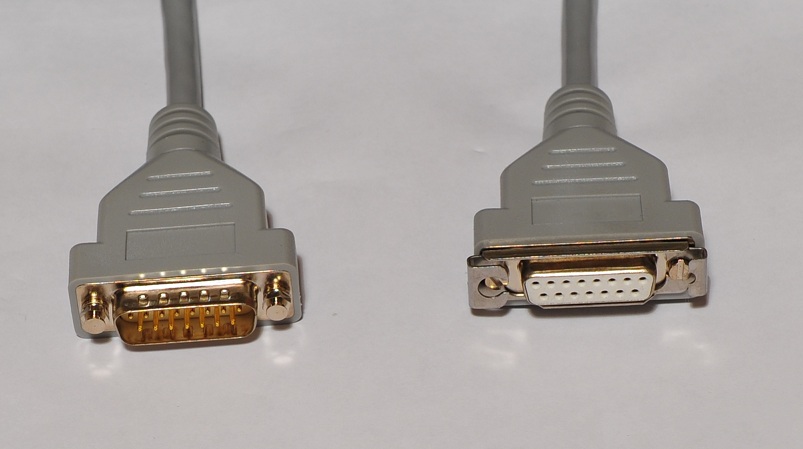 AUI drop cable, with a one-notch-up-from-useless slide locking mechanism |
MAUs (Media Attachment Units)
These metal boxes are one of the key defining pieces of kit in a 10BASE5 network. They function as the transceiver, converting the primitive signals from the AUI interface to what's required on the physical media, as well as performing collision detection. They came in 4 flavours:
- With a tap for 10BASE5 networks, using a Vampire Tap
- With a tap for 10BASE5 networks, using N connectors (Rare)
- With a tap for 10BASE2 networks, using BNC connectors
- Without a tap (Buy your own)
I chose Cabletron ST-500's, because they have blinky lights. The ST-500 (90 Series) would have been one of the last and most modern 10BASE5 MAUs manufactured. The internal component count (when compared with, say, a DEC h4000) is low.
 Cabletron ST500-01 (with AMP 228752-1 "Vampire tap") |
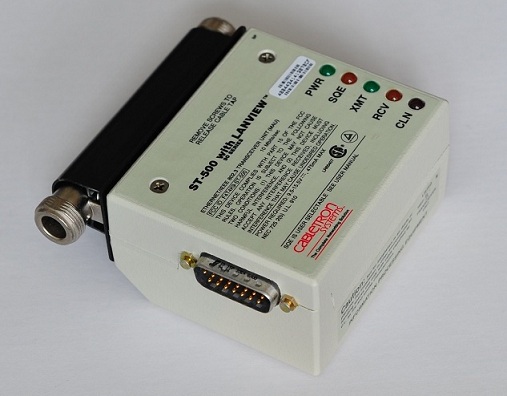 Cabletron ST500-02 (with AMP 221914-1 "N connector tap") |
Vampire taps
By far the most common means of connection to the coax segment. The bottom half is plastic, I assume to eliminate ground loops by ensuring the braid remains electrically isolated from the metal case of the MAU. The top half is extruded aluminium. Each contains three prongs (two to connect to the braid, and one to the centre conductor). To me, the idea of using this style of connection to coaxial cable is ambitious, but it has to be said that a few spikes in a coaxial cable will equate to significantly less reflection and insertion loss than cutting the cable and running through a couple of N connectors. I can imagine perfecting these taps was quite a headache for the designers of this system.
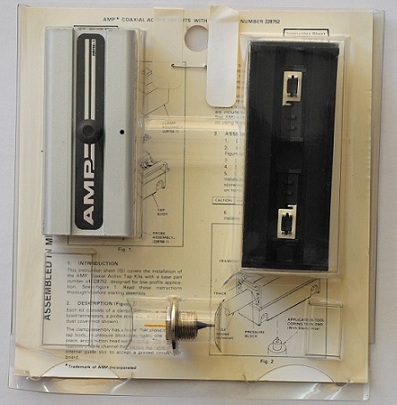 AMP 228752-1 in original packaging |
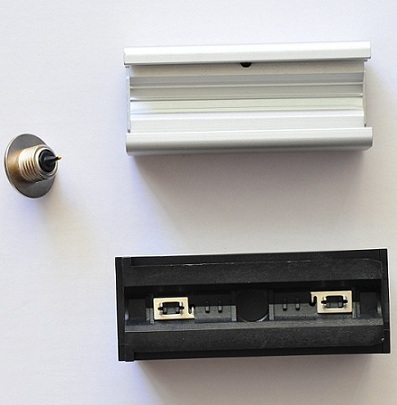 AMP 228752-1 dismantled view |
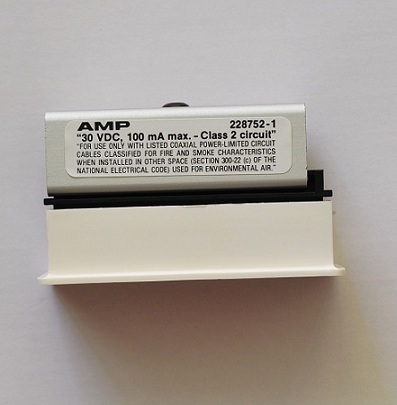 AMP 228752-1 side view |
N Connector taps
Not having seen one of these networks, or knowing anyone who's built one, unfortunately I do not have any information on what the typical use-case of this style of connection was. They're almost never seen for sale on eBay standalone or attached to a transceiver so from this I'd assume they were seldom used.
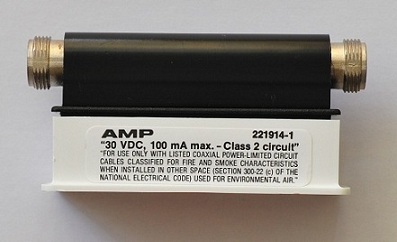 AMP 221914-1 in original packaging |
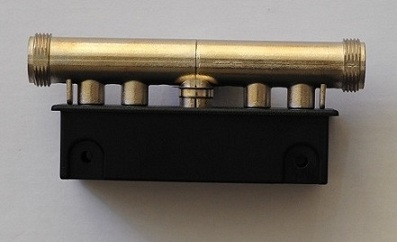 AMP 221914-1 with plastic cover removed |
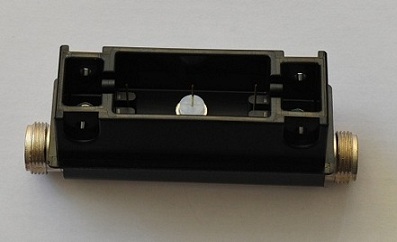 AMP 221914-1 bottom view |
Terminators
Like 10BASE2, 10BASE5 networks have to be terminated and earthed at one end, and terminated only at the other. Termination was a piece of cake on 10BASE2, simply a case of fitting one onto the unused ends of the tee connectors at each the end of the segment.
In a 10BASE5 network with every node on a vampire tap, this wouldn't have been quite so easy. I don't have any information about how these networks were terminated in a typical scenario but I guess an N connector would have to be crimped onto a short pigtail just beyond the last node, then a female to female coupler and terminator fitted (or a female terminator?).
Personally, I think terminating with an MAU and an N connector tap is much nicer but I doubt this was done often in practice.
Grounding was easy on 10BASE2, simply a case of connecting a short wire from one terminator to the back of the PC it terminated at. Considering that absolutely everything attached to my 10BASE5 network is double insulated, just where am I going to ground that thing? Hmmm...
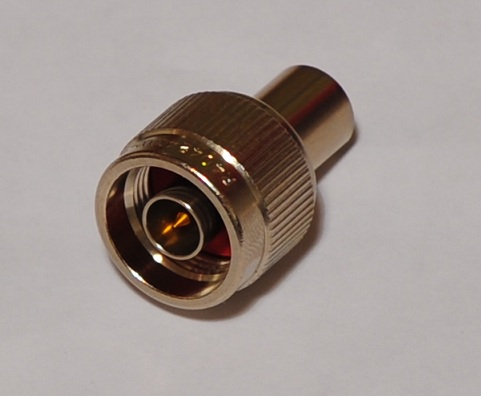 Standard N style 50 ohm terminator |
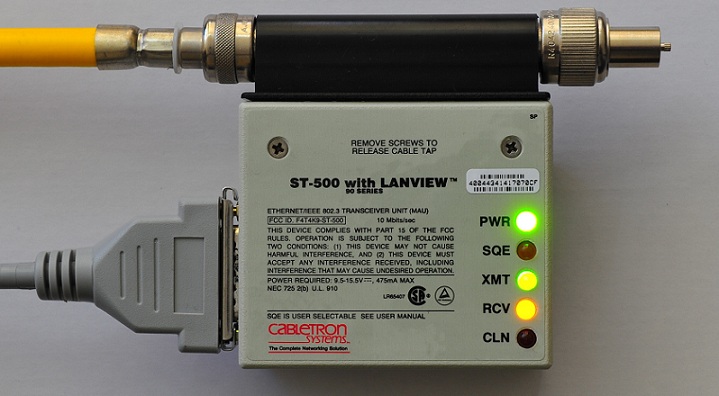 Cabletron ST500-02 (with AMP 221914-1) used to terminate a segment |
AUI to 10BASE-T Converters
I spent many hours on eBay over several months trying to find these. I did eventually obtain 3 identical MiLAN MIL-130A units which by the look of it, had been knocking around in someone's junk box for an awful long time. MIL-130A is one of only a small number of products ever manufactured to perform this conversion.
The key differentiating features from a 10BASE-T MAU are a female AUI connector, and a power input socket. They are in effect, a full Ethernet Repeater. They're based on a rather special, long-obsolete chip, the LXT906PC, which is designed exactly for this purpose.
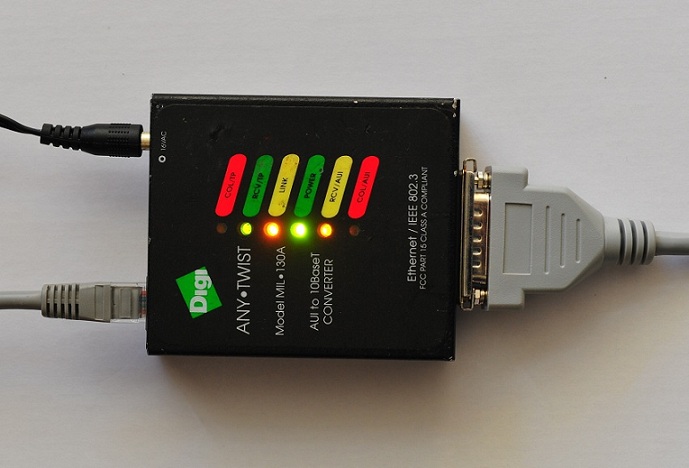 MiLAN MIL-130A connected to and powering an MAU |
Putting it all together
Preparing the Vampire Taps
 2 Vampire taps attached to a segment |
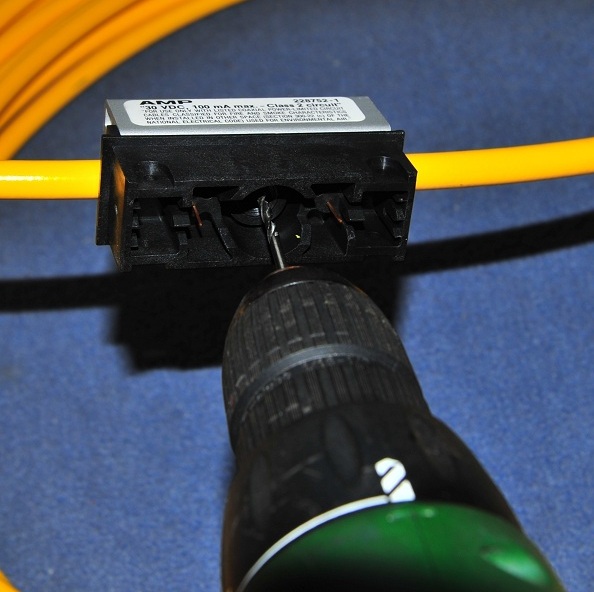 Drilling through the shielding |
Normally there's a coring tool which is used to drill down to the dielectric. Fat chance I was going to be able to get my hands on one of those. I'd have to do with a cordless drill. At first I thought this might be a bit dangerous but it actually worked pretty well. Just a few turns of the drill bit were all that were required to cleanly drill down to the top of the dielectric. If the drill has anything less than a very fine speed control, this is best done by hand.
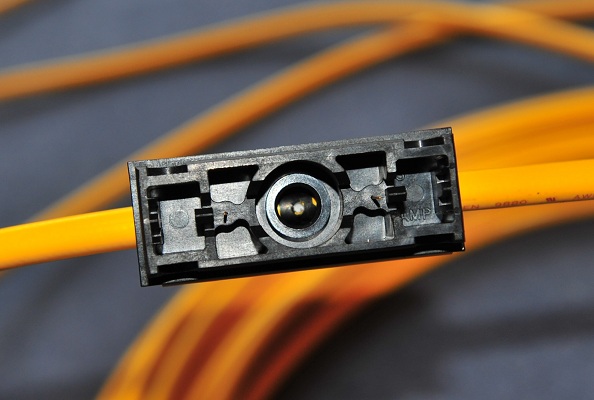 Freshly drilled tap, with white dielectric visible in the centre |
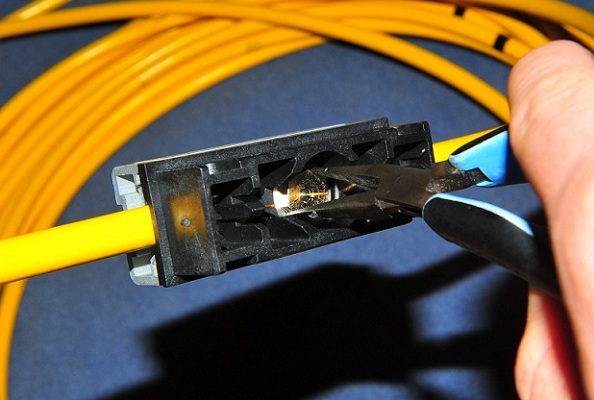 Screwing in the centre spike |
Turning it on
To my surprise, the network was passing traffic within seconds of first power on. The Vampire taps had worked perfectly and my terminators appear to have done the trick nicely. Just for kicks, I installed the second Vampire Tap with the network running, streaming video on one of the PCs. Not a single interruption!
Quirks
- It's not as if the manuals don't say it a hundred times, but SQE really must be disabled on the transceivers attached to the AUI-to-10BASE-T converters. Failure to do so results in an awful lot of collisions. Just to really cheese you off, MAUs always come with SQE enabled. Once you realise this, you've got to pull the whole lot apart again to get at the SQE switch underneath the tap
- There appears to be some interoperability issues between my MIL-130A converters and the Intel 82577LM network adapters in both of my Dell laptops, to the extent where packet loss exceeds 90%. No other network adapter I've tried has this problem
- Removing terminators while the network is running is not a good idea. When I did this, some pretty wild traffic must have been emitted by the AUI-to-10BASE-T converter, as it repeatedly manages to crash IOS on the Cisco Catalyst switch it was connected to
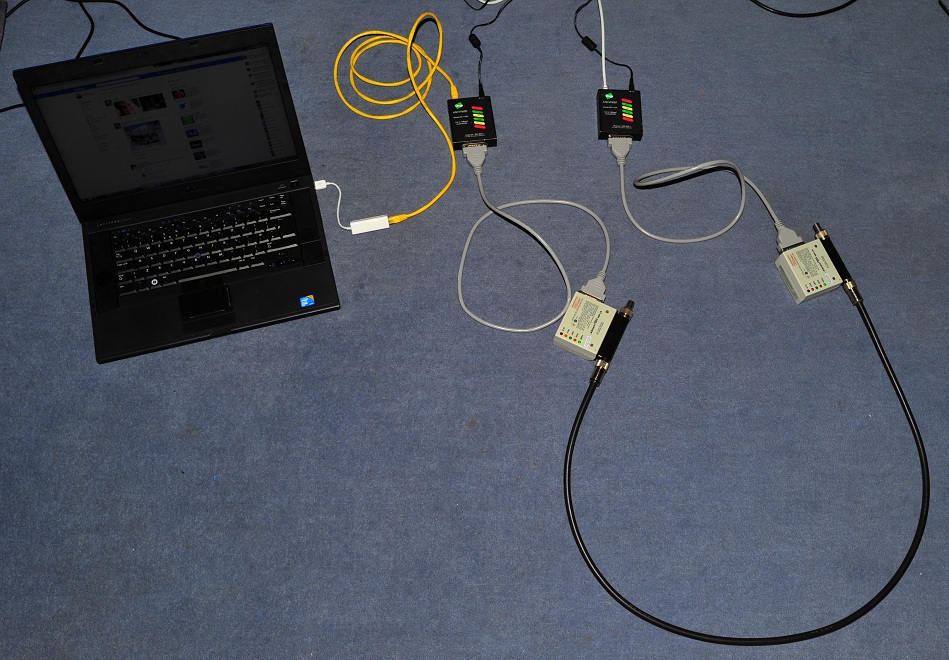 Using 10BASE-T media converters and RG-8/U cable. It's nice to know that 10BASE5 'does' Facebook. |
Conclusion
I've been very impressed with the workmanship of all of the components involved in this setup. Everything I have here is "Made in U.S.A.". I very much doubt that many gaming LANs would have taken place using this technology. Akin to wrestling with a giant anaconda, this stuff is big, bulky, expensive and generally quite difficult to deal with. It requires a lot of patience to assemble and once it's assembled, you're stuck with whatever configuration you built it in. No wonder I never came across it in my younger years. That said though, I'm happy to own this fully functioning piece of computing history.
